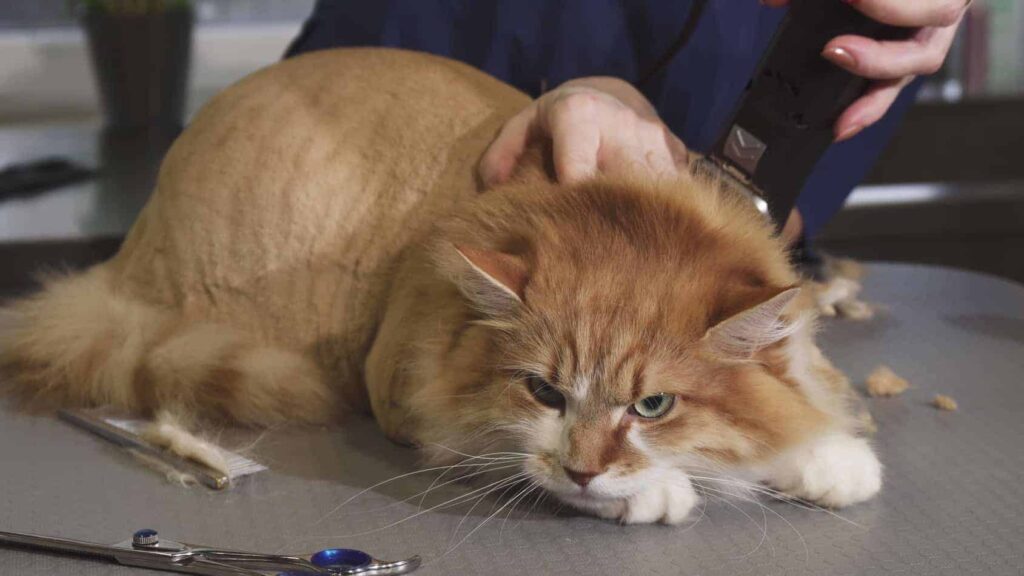A lion cut is a popular grooming style for cats, especially for those with long or dense coats. This distinctive cut involves shaving most of the fur off the body while leaving a “mane” around the neck and sometimes tufts of fur on the paws and tail. While it can be an aesthetic choice or a practical solution to a variety of grooming challenges, it’s important to understand how this cut might affect your cat’s overall health.
In this article, we’ll explore both the benefits and potential risks of giving your cat a lion cut, so you can make an informed decision for your furry friend.
The Benefits of a Lion Cut for Your Cat
- Prevents Matting and Tangling
Long-haired cats are particularly prone to matting, where the fur becomes tangled and knotted. If mats are left untreated, they can lead to skin irritation, discomfort, and even infections. A lion cut removes much of the fur that could become matted, offering relief for both the cat and its owner. For cats that tend to resist regular grooming, a lion cut can be a practical solution to avoid the pain and stress of de-matting.
- Reduces Shedding
For cats that shed excessively, the lion cut can help minimize loose fur around the home. Although the shedding will still occur, much of the hair is removed, leading to less fur accumulation in your home. This can be a relief for allergy sufferers or those who simply want to reduce the amount of cleaning needed to keep their house tidy.
- Improves Hygiene
Matted or excessively long fur can trap dirt, debris, and oils, creating an environment where bacteria and fungi can thrive. The lion cut offers an opportunity to clean the cat’s skin more effectively and prevent the buildup of such contaminants. For cats with skin conditions, removing the thick fur can also help reduce irritations and allow medications to work more effectively.
- Helps Regulate Body Temperature
During warmer months, a lion cut can help regulate your cat’s body temperature, especially in breeds with thick double coats. Cats with excess fur may become overheated, leading to stress, dehydration, or even heatstroke. A lion cut helps to reduce their fur density, allowing them to stay cooler. This is particularly beneficial for overweight cats or older cats who may have a harder time regulating their body temperature.
The Risks and Downsides of a Lion Cut
- Exposes Skin to the Elements
One of the biggest drawbacks of a lion cut is that it exposes your cat’s sensitive skin. Without the protection of fur, your cat is more vulnerable to sunburn, particularly in areas with little to no fur. If your cat spends time outdoors, this could lead to serious skin damage. Additionally, their skin may be more prone to abrasions, scratches, or insect bites, as the fur acts as a barrier.
- Skin Sensitivity and Irritations
After a lion cut, your cat’s skin may feel vulnerable and sensitive. Cats have delicate skin, and shaving can cause minor nicks or irritations if not done properly. This can lead to discomfort, itching, or even infection. Some cats may also develop dry skin or rashes, especially if they have a history of allergies or sensitivity to certain grooming products.
- Altered Coat Texture
Shaving the fur can affect how it grows back. In some cases, the coat may grow back in uneven patches or become coarser, which could lead to future grooming difficulties. Some cats may experience “fluffiness” or a change in coat texture that makes grooming more challenging and uncomfortable for them.
- Stress and Anxiety
While many cats tolerate grooming well, others may find the process stressful. The experience of being shaved or trimmed can be emotionally taxing, particularly for cats that are not accustomed to it. The lion cut may also cause anxiety due to the change in appearance, making your cat feel vulnerable or exposed. It’s important to monitor your cat’s behavior post-grooming to ensure they’re not experiencing undue stress.
Who Should Consider a Lion Cut?
While the lion cut can be beneficial for certain cats, it’s not suitable for every feline. Cats with long or dense coats, such as Persians, Maine Coons, or Ragdolls, often benefit the most from this grooming style. It can also be useful for cats with medical conditions that make grooming difficult or those that suffer from excessive matting.
However, if your cat has sensitive skin, a history of allergies, or is prone to sunburns, you might want to reconsider this grooming choice. Cats with short coats or those that don’t have significant grooming needs typically don’t require a lion cut. Always consult with a professional groomer or veterinarian before making the decision to shave your cat, as they can offer expert advice based on your cat’s health and grooming needs.

Final Thoughts: Is a Lion Cut Right for Your Cat?
A lion cut can be a game-changer for certain cats, providing relief from mats, reducing shedding, and promoting better hygiene. It can also help your cat stay cooler in hot weather. However, the potential downsides, such as skin exposure and sensitivity, make it a choice that should be considered carefully.
Before opting for a lion cut, assess your cat’s health, coat type, and lifestyle. If you’re unsure, seeking advice from your vet or a professional groomer is always a wise step. With the right care and grooming practices, your cat can remain happy and healthy, whether they sport a full coat or a trendy lion cut.




Your comment is awaiting moderation.
segelboot kroatien chartern https://eurosegeln.com/yachtcharter-kroatien